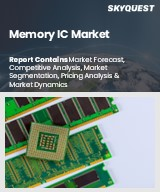
세계의 메모리 IC 시장 규모는 2023년에 31억 달러에 달하며, 예측 기간(2025-2032년)의 CAGR은 7.7%로, 2024년 33억 4,000만 달러에서 2032년까지 60억 4,000만 달러로 성장할 전망입니다.
세계 메모리 IC 시장은 다양한 분야에서 고성능 컴퓨팅에 대한 수요가 증가함에 따라 점점 더 많은 영향을 받고 있습니다. 데이터센터 및 엣지 컴퓨팅의 첨단 용도이 등장하면서 빠른 데이터 처리가 최우선 과제로 떠오르면서, 제조업체들은 최첨단 아키텍처를 갖춘 메모리 솔루션의 혁신을 주도하고 있습니다. 이러한 효율화의 움직임은 모바일 기기 및 네트워크 인프라에도 영향을 미쳐 낮은 지연과 높은 대역폭의 요구사항으로 이어집니다. 또한 3D 스태킹 및 MRAM과 같이 성능과 에너지 소비를 개선하는 새로운 유형의 메모리도 증가하고 있습니다. 또한 설계 툴의 발전과 업계내 협력적 노력으로 미래 메모리 기술에서 속도, 용량, 에너지 효율의 균형을 맞추고 지속가능성에 대한 우려를 해결하면서 메모리 집적도를 높이고 전력 소비를 줄이는 것을 목표로 하고 있습니다.
Global Memory IC Market size was valued at USD 3.1 billion in 2023 and is poised to grow from USD 3.34 billion in 2024 to USD 6.04 billion by 2032, growing at a CAGR of 7.7% during the forecast period (2025-2032).
The global memory IC market is increasingly influenced by the growing demand for high-performance computing across various sectors. As advanced applications in data centers and edge computing arise, the necessity for rapid data processing becomes paramount, prompting manufacturers to innovate memory solutions with cutting-edge architectures. This drive for efficiency permeates mobile devices and network infrastructure, leading to lower latency and higher bandwidth requirements. The market also sees a rise in novel memory types, such as 3D stacking and MRAM, which improve performance and energy use. Additionally, advancements in design tools and collaborative efforts within the industry aim to enhance memory integration and reduce power consumption, all while addressing sustainability concerns and balancing speed, capacity, and energy efficiency in future memory technologies.
Top-down and bottom-up approaches were used to estimate and validate the size of the Global Memory IC market and to estimate the size of various other dependent submarkets. The research methodology used to estimate the market size includes the following details: The key players in the market were identified through secondary research, and their market shares in the respective regions were determined through primary and secondary research. This entire procedure includes the study of the annual and financial reports of the top market players and extensive interviews for key insights from industry leaders such as CEOs, VPs, directors, and marketing executives. All percentage shares split, and breakdowns were determined using secondary sources and verified through Primary sources. All possible parameters that affect the markets covered in this research study have been accounted for, viewed in extensive detail, verified through primary research, and analyzed to get the final quantitative and qualitative data.
Global Memory IC Market Segments Analysis
Global Memory IC Market is segmented by Type, End-user Industry and region. Based on Type, the market is segmented into DRAM, Flash and Other Types. Based on End-user Industry, the market is segmented into Consumer Electronics, Automotive, IT & Telecommunication, Healthcare and Other End-user Industries. Based on region, the market is segmented into North America, Europe, Asia Pacific, Latin America and Middle East & Africa.
Driver of the Global Memory IC Market
The surge in data-intensive applications, especially in areas like artificial intelligence, machine learning, cloud computing, and the Internet of Things, has significantly heightened the need for high-performance memory integrated circuits (ICs). These applications demand rapid and high-capacity memory solutions to enable real-time data processing and storage capabilities. As a result, device manufacturers and infrastructure providers are increasingly investing in advanced memory technologies, including High Bandwidth Memory (HBM) and DDR5, alongside ongoing innovations in memory ICs. This investment trend is driving continuous growth in the global memory IC market across its entire value chain, reflecting a robust demand for enhanced memory solutions.
Restraints in the Global Memory IC Market
The Global Memory IC market faces notable constraints due to the substantial initial investment and technical know-how required for developing and producing advanced memory integrated circuits. The manufacturing facilities necessitate the use of highly specialized equipment, and the production process demands exceptional precision. Consequently, these factors establish high barriers to entry that restrict market participation primarily to a handful of dominant companies, thereby limiting overall competitiveness. This oligopolistic environment hampers the ability of smaller firms to innovate and share advancements, ultimately stifling the proliferation of new technologies and solutions within the industry.
Market Trends of the Global Memory IC Market
The Global Memory IC market is witnessing a transformative trend driven by the burgeoning demand for AI and machine learning applications. As industries increasingly adopt AI technologies, memory architectures are evolving to meet the requisite high-bandwidth and low-latency needs. Advanced options such as High Bandwidth Memory (HBM), GDDR6X, and Processing-In-Memory (PIM) are gaining momentum, particularly in AI accelerators and data centers. Memory IC manufacturers are collaborating with processor designers to create co-packaged modules that reduce energy consumption and enhance real-time inferencing capabilities by minimizing data transfer bottlenecks. This evolution reflects a shift towards more efficient and specialized memory solutions tailored for AI-driven workloads.